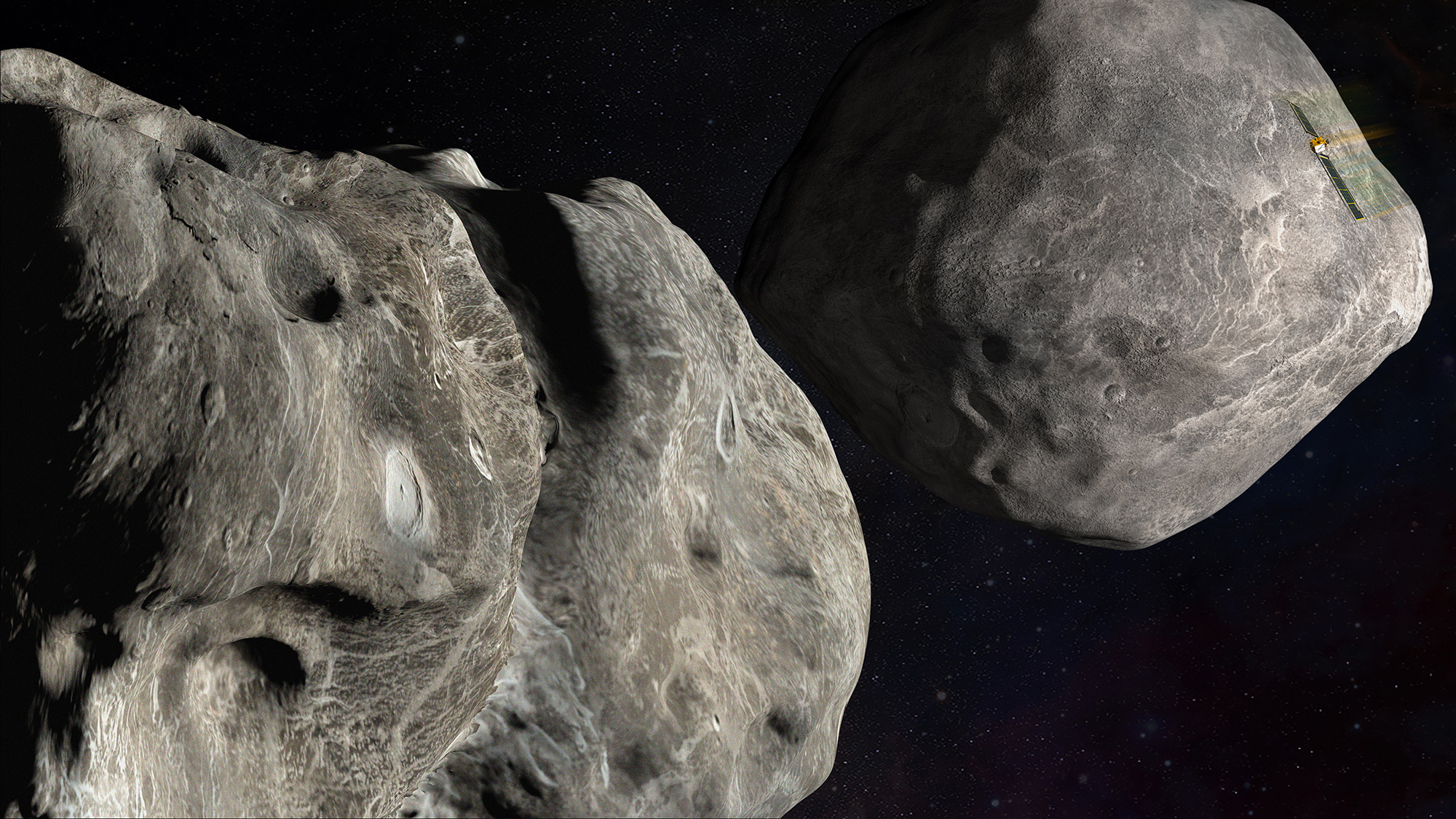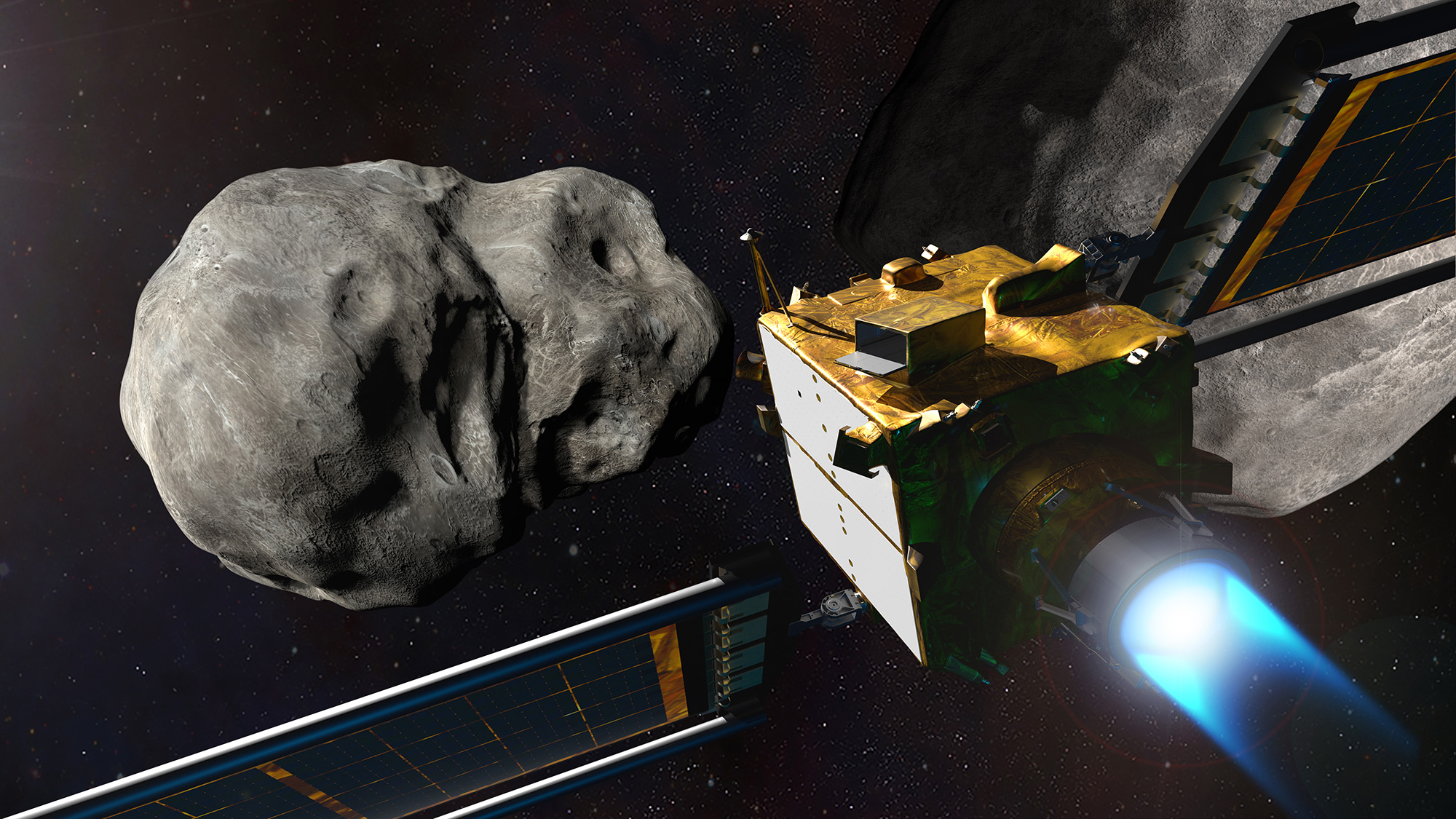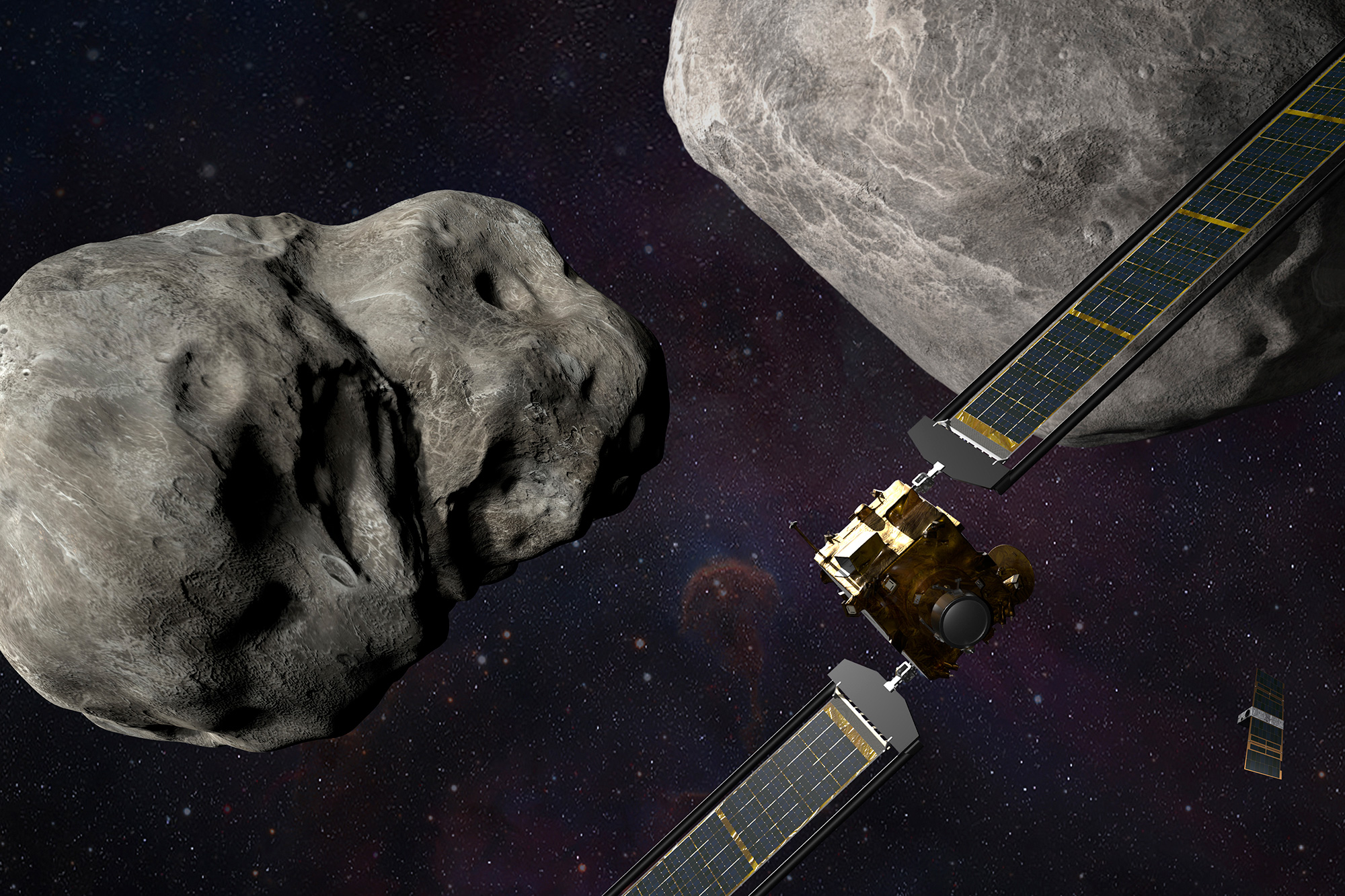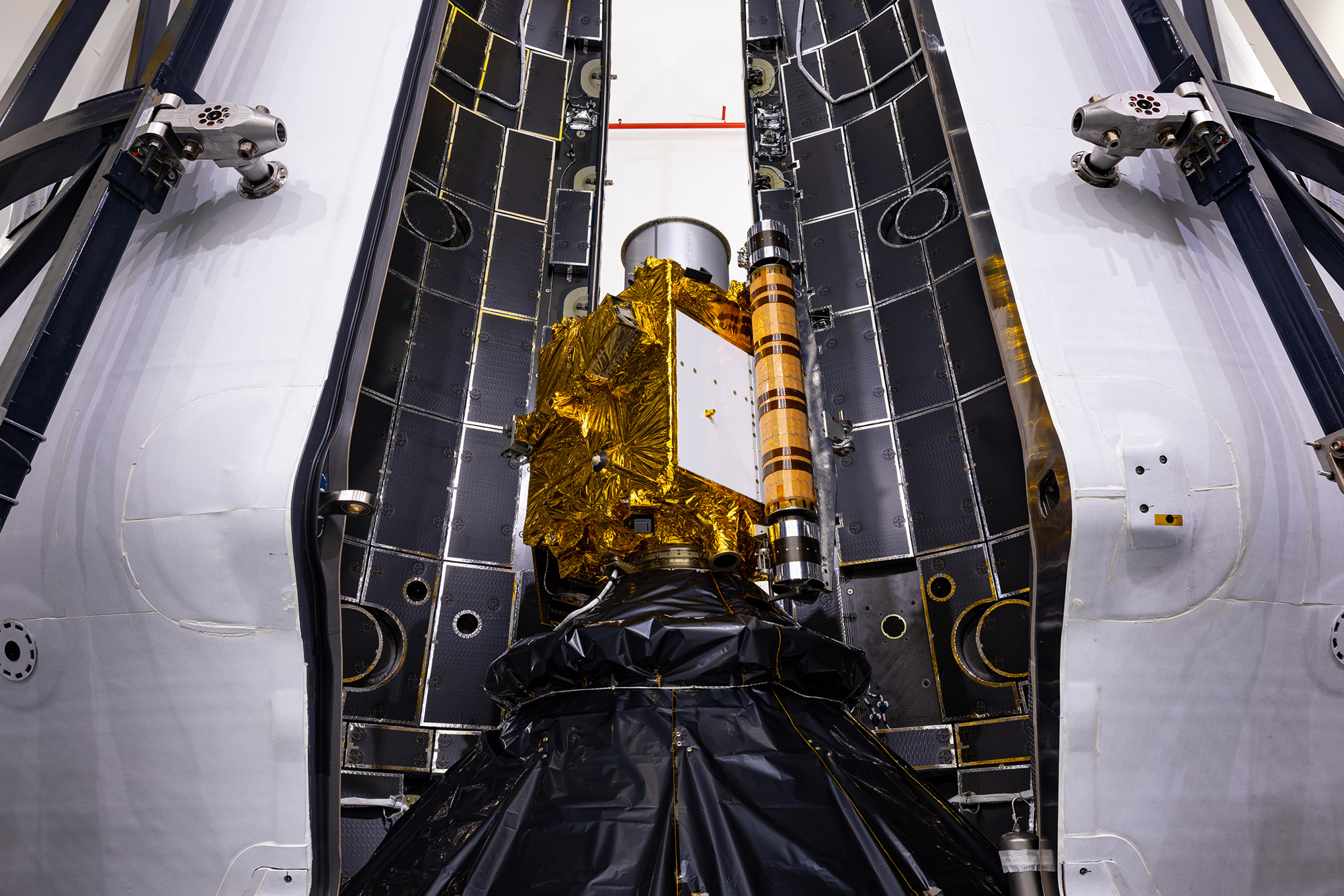DART is on a stable track with less than an hour to impact, mission engineer says
The DART spacecraft is on a stable track about an hour out from impact, a DART mission engineer said.
"We're very excited. We are starting to see Dimorphos for the first time. It is looking great. It is just about the same dimness as Didymos as we expected. And so, we are getting ready to transition. We have a stable track at this point," Elena Adams, DART mission engineer, said.
The spacecraft is heading for a double-asteroid system, where a tiny "moon" asteroid, named Dimorphos, orbits a larger asteroid, Didymos.
Here's the first live photo from the DART spacecraft of the asteroid Didymos
From CNN's Ross Levitt

For the first time, we are seeing live pictures from the DART spacecraft.
In the image, you can see a bright light.
NASA confirmed to CNN's Kristin Fisher that the light is Didymos, the larger of the two asteroids.
DART is aiming for Didymos but in the last moments will take aim at a smaller, nearby asteroid, Dimorphos, which orbits Didymos.
NASA is hoping to hit Dimorphos as part of humanity's first planetary defense test.
The DART spacecraft is heading to this asteroid system
From CNN's Ashley Strickland

The DART spacecraft is heading for a double-asteroid system, where a tiny "moon" asteroid, named Dimorphos, orbits a larger asteroid, Didymos.
Didymos, which means "twin" in Greek, is roughly 2,560 feet (780 meters) in diameter. Meanwhile, Dimorphos measures 525 feet (160 meters) across, and its name means "two forms."
At the time of impact, Didymos and Dimorphos will be relatively close to Earth — within 6.8 million miles (11 million kilometers).
Neither Dimorphos nor Didymos is at risk of colliding with Earth — before or after the collision takes place.
NASA is crashing a spacecraft into an asteroid. Here's why
From CNN's Ashley Strickland

The DART mission, or the Double Asteroid Redirection Test, is getting ready to deliberately crash into a space rock on Monday — and it's all in the name of protecting Earth.
The mission is heading for Dimorphos, a small moon orbiting the near-Earth asteroid Didymos. The asteroid system poses no threat, NASA officials have said, making it a perfect target to test out a kinetic impact – which may be needed if an asteroid is ever on track to hit the Earth.
The event will be the agency’s first full-scale demonstration of deflection technology that can protect the planet.
“For the first time ever, we will measurably change the orbit of a celestial body in the universe,” said Robert Braun, head of the Johns Hopkins University Applied Physics Laboratory’s Space Exploration Sector. Detecting the threat of near-Earth objects, or NEOs, that could cause grave harm is a primary focus of NASA and other space organizations around the world.
Dimorphos was chosen because its size is relative to asteroids that could be a threat. The spacecraft is about 100 times smaller than Dimorphos, so it won’t obliterate the asteroid.
“Sometimes we describe it as running a golf cart into a great pyramid or something like that,” Chabot said. “But for Dimorphos, this really is about asteroid deflection, not disruption. This isn’t going to blow up the asteroid; it isn’t going to put it into lots of pieces.”
Learn more about the mission
From CNN's Elise Hammond
The DART mission spacecraft is scheduled to collide shortly with a near-Earth asteroid.
Ahead of impact with Dimorphos at around 7:14 p.m. ET, here's what's happening, according to Elena Adams, the DART mission systems engineer at the Johns Hopkins University Applied Physics Laboratory.
4 hours before impact:
The spacecraft has become completely autonomous. Even though a team is watching data come into the command center “the spacecraft has to do everything," Adams said during a briefing on Thursday. At this point, the spacecraft is guiding itself toward Didymos, the larger asteroid in the system. It does this with the help of an instrument called the Didymos Reconnaissance and Asteroid Camera for Optical navigation, or DRACO, which will grab images of both celestial bodies and support the spacecraft's guidance system.
“It starts tracking it. It starting to guide itself toward Didymos," Adams said, referring to the bigger asteroid that is already visible. The smaller asteroid, Dimorphos, the mission's main target, is Didymos' moon.
1 hour before impact:
Dimorphos will come into view for the first time. The spacecraft will see the moon as "just one pixel” in the video of the DRACO camera, Adams said. Prior to Didymos and Dimorphos coming into view as tiny pinpricks of light a few hours before the collision, the camera is likely to be completely black. They will grow larger and larger until Dimorphos fills the entire frame just before impact.
“We’re going to execute a bunch of maneuvers, all autonomously," she said, describing how the spacecraft will be guided toward Dimorphos. While this is happening, the spacecraft will point the solar rays at the sun, which then sends data back to Earth at the rate of one image per second.
“After that we are going to precision lock," Adams said. “Which means we are now starting to ignore Didymos and we are only going to Dimorphos.”
2 1/2 minutes before impact:
The first photos of Dimorphos will be taken. Though it was discovered more than two decades ago, scientists have never seen what this asteroid looks like.
Impact:
“And then it will say 'loss of signal,' and we’ll all celebrate," Adams said.
NASA is set to crash a spacecraft into an asteroid — and, yes, you may have seen the movie
From CNN's Gene Seymour

There’s a giant rock ahead and NASA is crashing a spacecraft into it — and no, it's not a movie.
On Monday, the Double Asteroid Redirection Test, or DART, spacecraft is supposed to collide with Dimorphos, a small “moon” orbiting the near-Earth asteroid Didymos. NASA’s big idea here is to see whether using such unmanned hardware to nudge incoming space debris out of harm’s way is going to protect Earth in the future.
You know the routine. Somebody finds unmistakable evidence of a) an asteroid, b) a meteor, c) a comet, d) a rogue moon or e) a whole planet closing in on us. Who believes these warnings? Exactly nobody, until the skies are riddled with speeding debris sliding and shooting off the looming object. Then we either a) panic, b) submit or c) fly some of our own humans up there to save us all.
Take the most recent example of this subgenre, “Don’t Look Up.” Released last year in theaters and on Netflix, writer-director Adam McKay’s unruly political satire is set off by two Michigan State University astronomers (Jennifer Lawrence and Leonardo DiCaprio) who discover a comet that seems to have popped out of nowhere and within six months will collide with our planet hard enough to extinguish all life.
Before that, in 1998, there were two of these blockbusters: Michael Bay’s “Armageddon” and Mimi Leder’s “Deep Impact.”
The former, whose threat was a Texas-size asteroid, was a crowded, bombastic action thriller, rippling with broad humor and even broader set pieces with barely enough time for audience members to catch their breath.
The latter movie, whose threat was, as with “Don’t Look Up,” a comet, was a more earnest, conscientiously assembled and far less flustered variation on this theme.
If the real-life DART succeeds in its mission, we may be able to chill out more when asteroids start coming too close. But that doesn’t necessarily mean the movies will altogether abandon “Chicken Little” themes.
To read more, click here:
Here's what us mere earthlings will see from the mission
From CNN's Ashley Strickland
The spacecraft will share its view of the double-asteroid system through an instrument known as the Didymos Reconnaissance and Asteroid Camera for Optical navigation, or DRACO.
This imager, which serves as DART's eyes, will allow the spacecraft to identify the double-asteroid system and distinguish which space object it's supposed to strike.
This instrument also is a high-resolution camera that aims to capture images of the two asteroids to be streamed back to Earth at a rate of one image per second in what will appear nearly like a video. You can watch the live stream on NASA's website, beginning at 6 p.m. ET Monday.
Didymos and Dimorphos will appear as pinpricks of light about an hour before impact, gradually growing larger and more detailed in the frame.
Dimorphos has never been observed before, so scientists can finally take in its shape and the appearance of its surface.
We should be able to see Dimorphos in exquisite detail before DART crashes into it. Given the time it takes for images to stream back to Earth, they will be visible for 8 seconds before a loss of signal occurs and DART's mission ends — if it was successful.
The spacecraft also has its own photojournalist along for the ride.
A briefcase-size satellite from the Italian Space Agency hitched a ride with DART into space. Called the Light Italian CubeSat for Imaging of Asteroids, or LICIACube, it detached from the spacecraft on Sept. 11. The satellite is traveling behind DART to record what happens from a safe perspective.
Three minutes after impact, LICIACube will fly by Dimorphos to capture images and video of the impact plume and maybe even spy on the impact crater. The CubeSat will turn to keep its cameras pointed at Dimorphos as it flies by.
The images and video, while not immediately available, will be streamed back to Earth in the days and weeks following the collision.
As the spacecraft speeds toward an explosive collision, this should happen
From CNN's Ashley Strickland

The spacecraft of the DART mission, or the Double Asteroid Redirection Test, will be traveling at about 15,000 miles per hour when it hits Dimorphos, a small moon orbiting the near-Earth asteroid Didymos on Monday night.
Just before that collision, there will be a stream of about one image per second, providing humanity's first glimpse at the moonlet before the strike.
Didymos and Dimorphos will begin as small points of light and become larger as the spacecraft gets closer between 6 p.m. and 7:14 p.m. ET. And it will then cut to black when the spacecraft slams into the asteroid.
The space nudge will shift Dimorphos slightly and make it more gravitationally bound to Didymos – so the collision won’t change the binary system’s path around the Earth or increase its chances of becoming a threat to our planet, according to Nancy Chabot, planetary scientist and DART coordination lead at the Applied Physics Laboratory.
Dimorphos completes an orbit of Didymos every 11 hours and 55 minutes. After the impact, that may change to 11 hours and 45 minutes, but follow-up observations will determine how much of a shift occurred.
The DART spacecraft is about the size of a small car. Here's what else you should know
From CNN's Ashley Strickland

The DART mission lifted off on Nov. 23 aboard a SpaceX Falcon 9 rocket from Vandenberg Space Force Base in California.
Now, the spacecraft is getting closer to its target —the asteroid Dimorphos, a moon of a larger asteroid Didymos.
It is using an instrument called the Didymos Reconnaissance and Asteroid Camera for Optical navigation, or DRACO — which it will use to autonomously guide itself, as well as take some of the first pictures of Dimorphos.
During the event, these images will stream back to Earth at a rate of one per second, NASA scientists said.
The spacecraft is about 100 times smaller than Dimorphos — the size of a small car, according to scientists — so it won’t obliterate the asteroid. But it will use speed to make the difference that scientists are eager to witness.
The craft will accelerate at about 15,000 miles per hour (24,140 kilometers per hour) when it collides with the asteroid.
The speedy impact will only change Dimorphos’ speed by 1% as it orbits Didymos. It doesn't sound like a lot, but according to NASA, it will be enough to change the moon’s orbital period.


